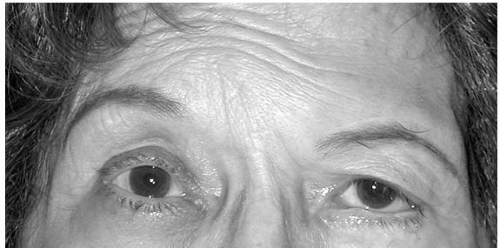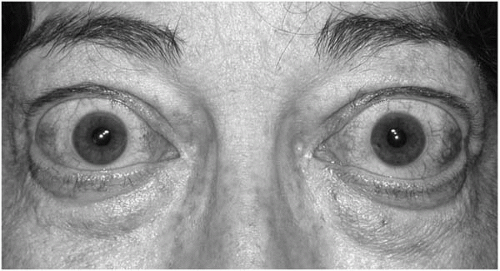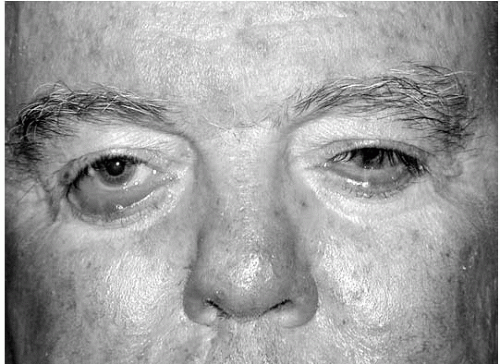Eye Plastics Considerations for the Anterior Segment Surgeon: Indications and Techniques
C. Robert Bernardino
Peter A. D. Rubin
EXPOSURE KERATOCONJUNCTIVITIS
Exposure keratoconjunctivitis is one of the most common anterior segment problems related to eyelid dysfunction. Common signs include conjunctival injection and chemosis in the interpalpebral zone, superficial punctate keratopathy, and, in advanced cases, corneal ulceration. Eyelid malposition, eyelid retraction or ectropion, and poor eyelid closure lead to lagophthalmos and subsequent ocular surface exposure. Involutional changes can lead to lateral canthal instability and ectropion (1). Eyelid retraction may occur secondary to cicatricial changes (Fig. 57-1), solar dermal changes, chronic inflammation from infections or ocular medications, or malignancies. And, of course, poor eyelid closure from facial nerve palsy can also cause lagophthalmos (2) (Fig. 57-2). Proptosis from an orbital mass or thyroid eye disease can also cause relative eyelid retraction and secondary exposure (Fig. 57-3). Conjunctival chemosis can cause persistent lagophthalmos and exposure keratopathy (Fig. 57-4A). Of note, the chemosis often does not resolve (Fig. 57-4B) until the exposure is eliminated.
Correcting the eyelid malposition leads to resolution of the anterior segment pathologic process in most cases of exposure keratoconjunctivitis. Eyelid retraction often resolves when the inflammation abates. Repair of ectropion with lateral canthal surgery improves exposure symptoms. Gold weight placement can address paralytic eyelid issues (2). Reduction of proptosis with decompression surgery or removal of intraorbital masses reduces the relative eyelid retraction.
Office-based procedures can temporarily treat exposure. Besides aggressive ocular lubrication, temporary tarsorrhaphies with glue (3) or sutures (4) are helpful, and botulinum toxin A has also been used to induce ptosis for exposure keratopathy (5).
Cyanoacrylate glue (medical grade) is used to create a temporary adhesion between either the eyelashes or the eyelid margins for a glue tarsorrhaphy. The eyelids are held together and the glue is carefully applied to the anterior lamellar surface only (Fig. 57-5). Care is taken not to allow the glue to seep posteriorly. If a lateral glue tarsorrhaphy is performed, the handle of a smooth instrument can be slid behind the eyelid as a backstop to protect the ocular surface. The eyelids should be held together for about 30 seconds to allow the glue to set. This type of tarsorrhaphy lasts approximately 4 weeks. If the tarsorrhaphy needs to be opened sooner, warm compresses help release the tarsorrhaphy, or the eyelashes can be cut if the lashes have been exploited for the gluing.
Suture tarsorrhaphy is a more definitive procedure than glue tarsorrhaphy. This can be accomplished in the cooperative patient under local anesthesia. This form of eyelid closure can be placed in a slipknot fashion, so as to allow opening of the eyelids for examination of the underlying globe (6). The main complication of this technique is premature release of the suture, usually from the suture cheese-wiring through the eyelid; this is most likely due to improper placement of the sutures through the tarsus. Bolsters also help distribute the tension of the sutures evenly across the eyelid surface.
To perform this procedure, local anesthetic is first administered in both eyelids, with care taken to anesthetize the eyelid margin. Permanent, nonbraided sutures (e.g., nylon) are preferable, single or double armed; double-armed sutures allow the surgeon to pass all the sutures in the same direction. We prefer sutures that are supplied in a foam container, so that bolsters can be fashioned from the packing material.
Both arms of a double-armed 5-0 nylon suture are first passed through a foam bolster, approximately 5 mm in width by 3 mm in height. One arm of the suture is then passed through the skin of the lower eyelid 5 mm below the eyelid margin. The tarsus is engaged and the suture is advanced until it exits through a meibomian gland orifice; this ensures that a proper bite of tarsus was taken. The upper eyelid is then engaged at the opposite meibomian gland orifice and the suture advanced until it exits the skin of the upper eyelid. The suture is then placed through a
second foam bolster. The other arm of the suture is passed in a similar fashion.
second foam bolster. The other arm of the suture is passed in a similar fashion.
The choice of location of the suture tarsorrhaphy is based on the clinical situation. A patient may need minimal closure assistance of the eyelids, in which case a laterally placed tarsorrhaphy is appropriate. However, in patients with extremely poor closure, central tarsorrhaphies are appropriate. In patients with massive proptosis or chemosis, multiple tarsorrhaphies across the eyelid reduce the tension across any individual suture. In cases of massive chemosis, the edematous conjunctiva may be deposited behind the eyelid with the handle of an instrument during placement of the tarsorrhaphy. Once the chemosis resolves, the tarsorrhaphy is often not needed.
A more permanent solution is needed for eyelid closure in some cases. Intermarginal adhesions must then be surgically created to ensure that a permanent adhesion will last. Most failures of this procedure occur because of the improper creation of these adhesions (7); skin closure is not sufficient for retention of a permanent tarsorrhaphy, and adhesion between the two tarsal plates, orbicularis, and skin is needed to ensure a lasting closure.
Local anesthetic is infiltrated into the eyelids, including the eyelid margins. Eyelid margin epithelium in the area of the tarsorrhaphy is excised; this bares underlying tarsus. The skin and pretarsal orbicularis are undermined to create a skin/muscle flap (Fig. 57-6A). It may be advisable to excise the lashes during this dissection. The skin/muscle flap is further divided into an orbicularis layer and the superficial eyelid skin layer. A similar procedure is performed on the opposite eyelid.
 FIGURE 57-2. A left facial nerve palsy causes orbicularis weakness and secondary lower eyelid retraction. Note the lack of forehead wrinkles and brow ptosis on the left secondary to the paralysis. |
 FIGURE 57-3. A patient with marked proptosis and eyelid retraction secondary to thyroid-related ophthalmopathy. |
Layered closure is performed to form the permanent tarsorrhaphy. Tarsus is approximated to the opposite tarsus with 5-0 polyglactin suture in a partial-thickness fashion (Fig. 57-6B); full-thickness sutures can rub on the underlying ocular surface and so should obviously be avoided. The orbicularis is then closed in a second layer, and finally the skin is closed. This three-layered closure ensures that the tarsorrhaphy will not open.
KERATOPATHY SECONDARY TO EYELID MALPOSITION
Lower eyelid malpositions (ectropion and entropion) can cause keratopathy. Keratopathy is typically secondary to exposure keratopathy as well as decreased lacrimal pump function (Fig. 57-7) in patients with ectropion, and to direct contact of the eyelashes and the keratinized eyelid skin with the ocular surface (Fig. 57-8) in entropion.
Most lower eyelid malpositions are caused by involutional changes based around the lateral canthal tendon. Depending on the forces generated by the orbicularis and the eyelid retractors, an eyelid with a lax lateral canthal tendon will either turn in or out (8). Therefore, the definitive repair of these malpositions is based around the lateral canthal tendon: the lateral tarsal strip procedure.
However, before repair of the lateral canthal tendon, it is often desirable to perform a temporizing procedure. Most cases of ectropion are temporized with aggressive lubrication. However, if severe lagophthalmos is present, a suture tarsorrhaphy is appropriate. A Quickert suture can redirect the eyelid until permanent repair is performed in patients with entropion (9). This technique is quite useful, particularly in
spastic entropion; the Quickert procedure allows the inflammation associated with the entropion to resolve and may allow the entropion to resolve without further intervention.
spastic entropion; the Quickert procedure allows the inflammation associated with the entropion to resolve and may allow the entropion to resolve without further intervention.
 FIGURE 57-4. A, Marked chemosis secondary to an allergic reaction to topical antibiotics. B, Chemosis induces lagophthalmos, which can cause worsening exposure and chemosis. |
To perform a Quickert suture, a double-armed, monofilament suture is essential; use of a single-armed suture necessitates the passing of the needle toward the globe, risking perforation. Like the suture tarsorrhaphy, we also prefer suture contained in a foam insert so the foam can be used to create a bolster to pass the suture through. Anesthesia is infiltrated into the lower eyelid, including the margin and fornix. The suture (5-0 nylon, double armed) is passed from the conjunctival fornix and directed anterior to tarsus to exit 3 mm inferior to the eyelid margin (Fig. 57-9A). The suture is passed through the bolster. The other arm of the suture is placed in a similar fashion. When the sutures are pulled taut, the eyelid should be slightly everted (Fig. 57-9B).
A lateral tarsal strip is performed to address permanently the lower eyelid malposition (10). In essence, the lower eyelid is shortened horizontally and sutured to Whitnall’s tubercle. A suture with a tight-curving needle (P-2) must be used to fasten the lower eyelid to the inner aspect of the lateral orbital rim.
Stay updated, free articles. Join our Telegram channel

Full access? Get Clinical Tree



